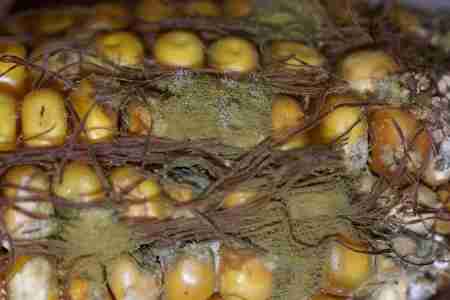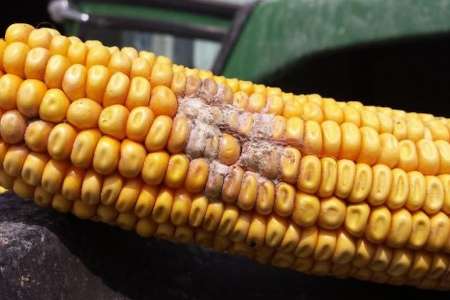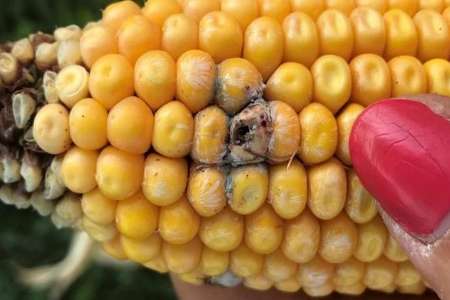By Erin Bowers and Charles Hurburgh et.al
The majority of Iowa is currently in moderate to severe drought, with west central Iowa under the most extreme drought. As if drought were not enough, we were dealt another blow with extreme and widespread wind damage on August 10, some of which overlapped the drought area. With these events come an increased risk for ear rots and associated mycotoxins. This article will address ear rots and mycotoxins of particular concern this year, in addition to scouting methods and monitoring considerations while grain is still in the field.
Aspergillus fungi are present in Iowa corn fields, and with the drought conditions, a significant risk of aflatoxins in the corn crop exists for the first time since 2012. Aflatoxins are a group of compounds that are produced primarily by Aspergillus flavus and Aspergillus parasiticus. These fungi grow on corn in the field causing Aspergillus ear rot and are particularly prevalent under hot, dry conditions. Aspergillus ear rot in corn is characterized by powdery olive-green mold that may be found at the ear tip or scattered over kernels elsewhere on the ear (Figure 1). Like other mycotoxins, aflatoxins are of concern because they cause a number of negative health effects in livestock and poultry. Additionally, aflatoxins are carcinogenic to humans.

Figure 1. The olive green, powdery mold that characterizes Aspergillus ear rot can be seen on this corn ear.
In certain parts of Iowa, Fusarium ear rot (Fusarium verticillioides and Fusarium proliferatum) and, subsequently, fumonisin mycotoxins may be present in corn this year. Fumonisin production in corn is associated with warm to hot temperatures and drought conditions, especially during grain maturation. Fusarium ear rot typically appears as a white to pink cottony mold scattered over the ear (Figure 2). Another characteristic symptom is a white starburst on the kernel surface (Figure 3), or brown discoloration of infected kernels (Figures 2 and 3).
Scouting
Now is the time to scout fields for ear rots, including those that have been flattened. Choose 5-10 locations in the field and examine 10-20 ears per location, peeling back the husks to assess mold. The fungi described above (and their mycotoxins) are often associated with damaged kernels in the field, or in harvested grain, with broken, lightweight and damaged kernels and fines. Armed with this information, a grower can think carefully about the degree to which scouting results may or may not be generalized within an individual field. It may be appropriate and more useful to examine sub-units of a field, which may be determined based on the extent of damage, intent to harvest, or other factors. Mycotoxin contamination is an insurable loss, but for both aflatoxin and fumonisin adjustment, the corn must still be in the field. You should not harvest it (or take other action) until the adjuster has visited the field. Scout now, scout often, and communicate results with a crop insurance adjuster.

Figure 2. A corn ear with Fusarium ear rot symptoms mid-ear.

Figure 3. A corn ear observed in Central Iowa in late August 2020 with kernels displaying the white “starburst” effect and other Fusarium ear rot symptoms. Additionally, while not laboratory-verified, the green mold appearing between kernels may be Aspergillus ear rot, given the weather conditions experienced in the region this growing season. Photo courtesy of Meaghan Anderson.
Crop conditions can change rapidly, especially in downed, damaged, and drought-stressed corn and with high fall temperatures during the daytime. While corn is in the field waiting to be harvested, it may continue to mold and accumulate mycotoxins. Scouting fields now and until harvest will alert growers to harvest priority or to the need for an initial or additional assessment by insurance adjusters. Take note, there is an implication here for ensuring that if testing is necessary, it is timed close to harvest as the levels in-field may continue to increase.
A discussion of harvesting, testing, and storing the 2020 crop is avialable in ‘2020 Drought and Derecho Impacted Corn-Harvest, Mycotoxin Testing and Storage’.
Source : iastate.edu